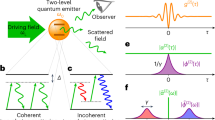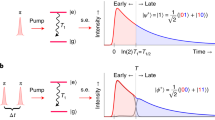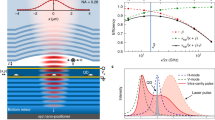Abstract
When two indistinguishable single photons are fed into the two input ports of a beam splitter, the photons will coalesce and leave together from the same output port. This is a quantum interference effect, which occurs because two possible paths—in which the photons leave by different output ports—interfere destructively. This effect was first observed in parametric downconversion1 (in which a nonlinear crystal splits a single photon into two photons of lower energy), then from two separate downconversion crystals2, as well as with single photons produced one after the other by the same quantum emitter3,4,5,6. With the recent developments in quantum information research, much attention has been devoted to this interference effect as a resource for quantum data processing using linear optics techniques2,7,8,9,10,11. To ensure the scalability of schemes based on these ideas, it is crucial that indistinguishable photons are emitted by a collection of synchronized, but otherwise independent sources. Here we demonstrate the quantum interference of two single photons emitted by two independently trapped single atoms, bridging the gap towards the simultaneous emission of many indistinguishable single photons by different emitters. Our data analysis shows that the observed coalescence is mainly limited by wavefront matching of the light emitted by the two atoms, and to a lesser extent by the motion of each atom in its own trap.
This is a preview of subscription content, access via your institution
Access options
Subscribe to this journal
Receive 51 print issues and online access
$199.00 per year
only $3.90 per issue
Buy this article
- Purchase on Springer Link
- Instant access to full article PDF
Prices may be subject to local taxes which are calculated during checkout




Similar content being viewed by others
References
Hong, C. K., Ou, Z. Y. & Mandel, L. Measurement of subpicosecond time intervals between two photons by interference. Phys. Rev. Lett. 59, 2044–2046 (1987)
de Riedmatten, H., Marcikic, J., Tittel, W., Zbinden, M. & Gisin, N. Quantum interference with photon pairs created in spatially separated sources. Phys. Rev. A 67, 022301 (2003)
Varoutsis, S. et al. Restoration of photon indistinguishability in the emission of a semiconductor quantum dot. Phys. Rev. B 72, 041303(R) (2005)
Legero, T., Wilk, T., Hennrich, M., Rempe, G. & Kuhn, A. Quantum beat of two single photons. Phys. Rev. Lett. 93, 070503 (2004)
Kiraz, A. et al. Indistinguishable photons from a single molecule. Phys. Rev. Lett. 94, 223602 (2005)
Santori, C., Fattal, D., Vučković, J., Salomon, G. S. & Yamamoto, Y. Indistinguishable photons from a single-photon device. Nature 419, 594–597 (2002)
Dowling, J. P., Franson, J. D., Lee, H. & Milburn, G. J. Towards scalable linear-optical quantum computers. Quantum Inf. Process. 3, 205–213 (2004)
Pan, J.-W., Bouwmeester, D., Weinfurter, H. & Zeilinger, A. Experimental entanglement swapping: entangling photons that never interacted. Phys. Rev. Lett. 80, 3891–3894 (1998)
Knill, E., Laflamme, R. & Milburn, G. J. A scheme for efficient quantum computation with linear optics. Nature 409, 46–52 (2001)
Lim, Y. L., Beige, A. & Kwek, L. C. Repeat-until-success linear optics distributed quantum computing. Phys. Rev. Lett. 95, 030505 (2005)
Barrett, S. D. & Kok, P. Efficient high-fidelity quantum computation using matter qubits and linear optics. Phys. Rev. A 71, 060310 (2003)
Zoller, P., Cirac, J. I., Duan, L. & García-Ripoll, J. J. in Les Houches, Session LXXIX, 2003—Quantum Entanglement and Information Processing (eds Estève, D., Raimond, J.-M. & Dalibard, J.) 187–222 (Elsevier, Amsterdam, 2004)
Paillard, M. et al. Spin relaxation quenching in semiconductor quantum dots. Phys. Rev. Lett. 86, 1634–1637 (2001)
Monroe, C., Meekhof, D. M., King, B. E., Itano, W. M. & Wineland, D. J. Demonstration of a fundamental quantum logic gate. Phys. Rev. Lett. 75, 4714–4717 (1995)
Schrader, D. et al. Neutral atom quantum register. Phys. Rev. Lett. 93, 150501 (2004)
Simon, C. & Irvine, W. T. M. Robust long-distance entanglement and a loophole-free Bell test with ions and photons. Phys. Rev. Lett. 91, 110405 (2003)
Blinov, B. B., Moehring, D. L., Duan, L.-M. & Monroe, C. Observation of entanglement between a single trapped atom and a single photon. Nature 428, 153–157 (2004)
Bergamini, S. et al. Holographic generation of microtrap arrays for single atoms by use of a programmable phase modulator. J. Opt. Soc. Am. B 21, 1889–1894 (2004)
Schlosser, N., Reymond, G., Protsenko, I. & Grangier, P. Sub-poissonian loading of single atoms in a microscopic dipole trap. Nature 411, 1024–1027 (2001)
Dingjan, J. et al. A frequency-doubled, pulsed laser system for rubidium manipulation. Appl. Phys. B 82, 47–51 (2006)
Darquié, B. et al. Controlled single-photon emission from a single trapped two-level atom. Science 309, 454–456 (2005)
Legero, T., Wilk, T., Kuhn, A. & Rempe, G. Time-resolved two-photon quantum interference. Appl. Phys. B 77, 797–802 (2003)
Acknowledgements
We acknowledge support from the European Union through the Integrated Project ‘SCALA’. J.D. was funded by Research Training Network ‘CONQUEST’. M.P.A.J. was supported by a Marie Curie fellowship.
Author information
Authors and Affiliations
Corresponding author
Ethics declarations
Competing interests
Reprints and permissions information is available at npg.nature.com/reprintsandpermissions. The authors declare no competing financial interests.
Supplementary information
Supplementary Notes
This file contains discussion about: the normalized height of the residual peak for non-interfering photons; alignment of the optical system and limits on spatial overlap; and the effect of the inhomogeneous broadening on the shape of the residual peak at zero delay, including one figure. (PDF 60 kb)
Rights and permissions
About this article
Cite this article
Beugnon, J., Jones, M., Dingjan, J. et al. Quantum interference between two single photons emitted by independently trapped atoms. Nature 440, 779–782 (2006). https://doi.org/10.1038/nature04628
Received:
Accepted:
Issue Date:
DOI: https://doi.org/10.1038/nature04628
This article is cited by
-
The resonance fluorescence cascade of a laser-excited two-level atom
Advances in Continuous and Discrete Models (2023)
-
Quantum interference of identical photons from remote GaAs quantum dots
Nature Nanotechnology (2022)
-
Quantum science with optical tweezer arrays of ultracold atoms and molecules
Nature Physics (2021)
-
Metasurfaces for quantum photonics
Nature Photonics (2021)
-
Experimental Hong—Ou—Mandel interference using two independent heralded single-photon sources
Frontiers of Optoelectronics (2021)
Comments
By submitting a comment you agree to abide by our Terms and Community Guidelines. If you find something abusive or that does not comply with our terms or guidelines please flag it as inappropriate.



